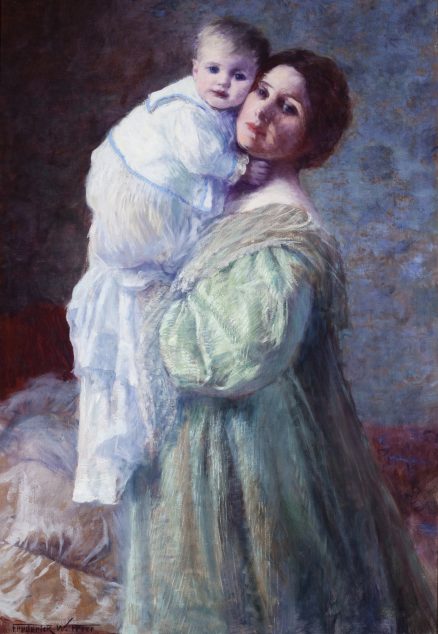- Categories
- Children
- Figural works
- Women
- Zoom in on Artwork
- Print Page
- Email Page to Friend
The young woman in Frederick W. Freer’s painting holds her baby up close to her cheek in a gesture of mingled tenderness and maternal pride. The paired figures’ loose, voluminous clothing, the soft bedding visible just behind them, and the cool daylight flooding in from the left all suggest early morning and the first familial embrace of a new day. The immediacy of the subjects’ direct gaze further personalizes this intimate image, at once an icon of maternity and a portrait of specific individuals.
Baby is one of many paintings of mothers and children for which Freer was widely noted by the time he resettled permanently in his hometown of Chicago, in 1890. His perennial model was his wife, fellow artist Margaret Keenan. Following the birth of the first of their six children in 1888, mother-and-child images dominated in Freer’s work. In June 1896 the Chicago Post reported, “Among the unfinished canvases [in Freer’s studio] is one to be completed this summer of a fair and gracious lady, richly robed, holding a beautiful child against her cheek. It holds a promise of peachy tints and high, joyous key. It should be called ‘The Flower and the Bud.’”i Instead, it was titled Baby in the inaugural annual exhibition of the Society of Western Artists at the Art Institute of Chicago, the first stop on the show’s tour of six midwestern cities. The painting also appeared in the Trans-Mississippi and International Exposition in Omaha in 1898 and in the Boston Art Club’s annual exhibition the following year. With the title The Young Mother it was reproduced in periodicals in 1900 and 1903, making it among Freer’s best-known images in the mother-and-child genre.
Freer pursued this theme in an era of new attitudes toward child-rearing, as the sentimental Victorian cult of motherhood dovetailed with growing recognition of the importance of maternal nurturing on a child’s development. His painting struck a contemporary note in its emphasis on the physical intimacy between mother and child. It was also notably modern in style and technique in its open brushwork and bright highlights, hallmarks of the modified impressionism that many of America’s progressive painters adopted in the 1890s. Freer’s use of an almost-dry brush, his distinct paint strokes, and his slightly blurred rendering of the faces all mimic the effects of pastel, a medium favored by the impressionists; indeed, Freer was reportedly experimenting in pastel at just the time he was completing Baby.
Wendy Greenhouse, PhD
Donated by M. Christine Schwartz to The Richard H. Driehaus Museum, Chicago, Illinois, in 2022
i “Art and Artists,” Chicago Post, June 27, 1896.
